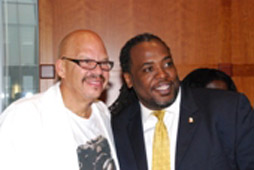|
:: Privatized Prisons Are Big Business - By Junious Ricardo Stanton ::

“Prison stocks also are valued on a “per
bed” basis — which is based on the number of beds provided and the profit per
bed. “Per bed” is really a euphemism for people who are sentenced to be housed
in their prison. For example, in 1996, when Cornell Corrections went public,
based on the financial information provided in the offering document provided to
investors, its stock was valued at $24,241 per bed. This means that for every
contract Cornell got to house one prisoner, at that time, their stock went up in
value by an average of $24,261. According to prevailing business school
philosophy, this is the stock market’s current present value of the future flow
of profit flows generated through the management of each prisoner. This, for
example, is why longer mandatory sentences are worth so much to private prison
stocks. A prisoner in jail for twenty years has a twenty-year cash flow
associated with his incarceration, as opposed to one with a shorter sentence or
one eligible for an early parole.[47] This means that we have created a
significant number of private interests — investment firms, banks, attorneys,
auditors, architects, construction firms, real estate developers, bankers,
academics, investors among them— who have a vested interest in increasing the
prison population and keeping people behind bars as long as possible.” Catherine
Austin Fitts Dillon Read and Company And The Aristocracy of Prison Profits http://dunwalke.com/introduction.htm
The United States of AmeriKKKa imprisons more of its citizens than any other
nation on the planet. Currently almost two and a quarter million persons
languish in local, county, state and federal prisons. Looking at the AmeriKKKan
gulag we see some very disturbing trends aside from the disproportionate
incarceration of people of color. Investments in the prison industrial complex,
prison construction, privatization of prisons and public policies that encourage
incarceration over intervention and treatment are fueling the rise of prison
construction and incarceration at a time when even according to FBI statistics
major crimes are decreasing! Nothing occurs in a vacuum. Those of us who
comprehend the Law of Karma (cause and effect, sowing and reaping) know the
large number of prisoners especially of people of color is the effect of causes
put into action years ago by the ruling elites and their flunkies. They glean a
slice of how this happened and the boardroom and public policy causes (read
Catherine Austin Fitts revealing piece entitled Dillon Read and Company And The
Aristocracy of Prison Profits at http://dunwalke.com/introduction.htm). Her
insightful and well documented article reveals the causative factors in the
private prison boom as it relates to just one financial firm, Dillon Read, a
stodgy Wall Street private investment banking firm.
From Catherine Austin Fitts article we can extrapolate just how the real
criminals have rigged the game and structured a gulag system that would make
Stalin or Hitler blush with envy. Only in this case the prime motive is not
oppression or repression of dissidents its money with an underlying tinge of
racism. This is nothing new. Collusion between local and state governments and
plantations, mining interests and corporations has a sordid history in
AmeriKKKa. Horror stories abound about the abysmal and dehumanizing conditions
these business arrangements between the government and moneyed interests
created. Unfortunately, these business arrangements between governments, for
profit private prisons and corporations are making a comeback. “A hundred years
ago private prisons were a familiar feature of American life, with disastrous
consequences. Prisoners were farmed out as slave labor. They were routinely
beaten and abused, fed slop and kept in horribly overcrowded cells. Conditions
were so wretched that by the end of the nineteenth century private prisons were
outlawed in most states. During the past decade, private prisons have made a
comeback. Already 28 states have passed legislation making it legal for private
contractors to run correctional facilities and many more states are expected to
follow suit.” US: America's Private Gulag by Ken Silverstein, Prison Legal News http://www.corpwatch.org/article.php. The article I just quoted was
written in 2000.
Since then there has been a steady rise in the number of government and
private prisons constructed but the privatization of prisons is increasing at an
alarming rate. “At the start of Reagan's administration in 1980, there were
approximately 501,886 prisoners in the nation's prisons and jails, according to
the Bureau of Justice Statistics. In June 2001, there were 1,800,300, a nearly
four-fold increase, according to the agency's data. Of this number, 803,400 were
Black males and 69,500 were Black females.
One of the effects of this boom has been the shifting of federal funds from
the minority and poor communities that export prisoners to poor white towns,
which started "hosting" prisons in the 1990s as a means of escaping from
economic despair. In fact, new studies are showing that in a society that
ratcheted up its criminal penalties to control crime and place offenders out of
sight and out of mind, the prison industry has begun to affect the political
landscape.” Crime & Punishment How the US prison
system makes minority communities pay http://www.prisonpolicy.org/news/crisis_july2002.shtml
To the ruling elites the clang of cell doors was also a big ka-ching for
investors and corporate types looking to get rich but first they had to use
their pull with the politicians to pass laws to make more necessary. “The
“pop” is a word I learned on Wall Street to describe the multiple of income at
which a stock is valued by the stock market. So if a stock like Cornell
Corrections trades at 15 times it's income, that means for every $1 million of
net income it makes, it's stock goes up $15 million. The company may make $1
million, but its “pop” is $15 million. Folks make money in the stock market from
the stock going up. On Wall Street, it's all about “pop.” Prison stocks also are
valued on a “per bed” basis — which is based on the number of beds provided and
the profit per bed. “Per bed” is really a euphemism for people who are sentenced
to be housed in their prison.
For example, in 1996, when Cornell went public, based on the financial
information provided in the offering document provided to investors, its stock
was valued at $24,241 per bed. This means that for every contract Cornell
got to house one prisoner, at that time, their stock went up in value by an
average of $24,261. According to prevailing business school philosophy, this is
the stock market’s current present value of the future flow of profit flows
generated through the management of each prisoner. This, for example, is why
longer mandatory sentences are worth so much to private prison stocks. A
prisoner in jail for twenty years has a twenty-year cash flow associated with
his incarceration, as opposed to one with a shorter sentence or one eligible for
an early parole.[47] This means that we have created a significant number of
private interests — investment firms, banks, attorneys, auditors, architects,
construction firms, real estate developers, bankers, academics, investors among
them— who have a vested interest in increasing the prison population and keeping
people behind bars as long as possible.
When you invest in stock, you make money if and when you sell the stock at a
higher price than you paid for it. This would be true for the people who
invested in Cornell stock, including Dillon Read and its venture funds. Cornell
was run by a board of directors that represented the shareholders, particularly
the controlling shareholders — in this case Dillon Read. The board is the group
of people who decides what goes. Senior management officials, such as the
founder and Chairman David Cornell, who run the company day to day, are also on
the board. Most of the money they make comes from stock options that they get to
encourage them to get the stock to go up for the investors. That means that what
everyone who runs the company wants is for the stock to go up”. ” Catherine
Austin Fitts Dillon Read and Company And The Aristocracy of Prison Profits
http://dunwalke.com/introduction.htm The dye had been cast and all that was
needed was for the moneyed crowd to make the connection with the politicians who
would make public policy that would make their bank accounts blossom and prisons
a major cash cow. “Much has been written about the use of the War on Drugs to
intentionally disenfranchise poor people and engineer the centralization of
political and economic power in the U.S. and globally, including an explosive
rise in the U.S. prison population. The purpose of this story is not to repeat
this fundamentally sound thesis. For those who are interested in more on this
topic, I would refer you to my article and audio seminar “Narco Dollars for
Beginners” as well as Michael Woodiwiss’ book Organized Crime and American Power
(University of Toronto Press, 2001) and their associated bibliographies. [49]
What most people miss is the extent to which the day-to-day implementation of
this intentional centralism is deeply pervasive and therefore deeply bipartisan. It receives the promotion and support from all political and social spectrums
that make money by running government through the contractors, banks, law firms,
think tanks and universities that really run the government. My intention for
this story is to make clear how the system really works. A system in which a
small group of ambitious insiders — who more often than not were educated at
Harvard, Yale, Princeton and the other Ivy League schools — enjoy centralizing
power and advantaging themselves. Paradigms of Republican vs. Democrat or
Conservative vs. Progressive have been designed for obfuscation and
entertainment. An endless number of philosophies and strains of religious and
‘holier than thou’ moralism are really put on and taken off like fresh make-up
in the effort to hide from view a deeper, uglier face.” ibid. This is part of
the ongoing class war in AmeriKKKa. These elites from exclusive universities who
have backgrounds in banking, law, intelligence and politics make the rules and
then initiate programs and public policies designed primarily to fatten their
portfolios and bank accounts.
As Catherine said, it is a bipartisan effort. Bill Clinton the man our
“Negro leadership” loves so much was a key figure in the prison boom which led
to the incarceration of hundreds of thousands of black and brown folks across
the nation. “The Clinton Administration took the groundwork laid by Nixon,
Reagan and Bush and embraced and blossomed the expansion and promotion of
federal support for police, enforcement and the War on Drugs with a passion that
was hard to understand unless and until you realized that the American financial
system was deeply dependent on attracting an estimated $500 billion-$1 trillion
of annual money laundering. Globalizing corporations and deepening deficits and
housing bubbles required attracting vast amounts of capital. Attracting capital
also required making the world safe for the reinvestment of the profits of
organized crime and the war machine. Without growing organized crime and
military activities through government budgets and contracts, the economy would
stop centralizing. The Clinton Administration was to govern a doubling of the
federal prison population. [50] Whether through subsidy, credit and asset
forfeiture, kickbacks to state and local government, Five Years Later: Do you
Feel Safer Yet?" or increased laws, regulations and federal sentencing and
imprisonment, the supremacy of the federal enforcement infrastructure and the
industry it feeds was to be a Clinton legacy. ” Dillon Read and Company And The
Aristocracy of Prison Profits http://dunwalke.com/introduction.htm It was under
our man Bill Clinton the one our sell out leadership like to call “the First
Black President” that increasing numbers of Africans in America were
incarcerated compared to whites who committed far more serious crimes, a fact
which was pointed out to him by the Sentencing Project but he elected to do
nothing to rectify.
“About three-quarters of new admissions to American jails and prisons are now
African-American and Hispanic men. This trend, combined with an increasingly
privatized and profitable prison system run largely by whites, makes for what
Jerome Miller, a former youth corrections officer in Pennsylvania and
Massachusetts, calls the emerging Gulag State. Miller predicts that the Gulag
State will be in place within 15 years. He expects three to five million people
to be behind bars, including an absolute majority of African-American men. It's
comparable, he says, to the post-Civil War period, when authorities came to view
the prison system as a cheaper, more efficient substitute for slavery. Of the
state's current approach to crime and law enforcement, Miller says, ‘The race
card has changed the whole playing field. Because the prison system doesn't
affect a significant percentage of young white men we'll increasingly see
prisoners treated as commodities. For now the situation is a bit more benign
than it was back in the nineteenth century but I'm not sure it will stay that
way for long.”
This pattern of creating policies that criminalize and incarcerate increasing
numbers of black and brown people for longer periods will continue unless and
until we do something about it! Draconian laws, using government
manufactured terrorism as a scare tactic to usher in a bourgeoning police state
will swell the prison ranks even more unless we take serious action. “Blacks
have also been disproportionately affected by the national ‘war on drugs’,
carried out primarily through the arrest, prosecution and imprisonment of street
level drug offenders from inner city communities. In 1996, for example, blacks
constituted 62.6 percent of all drug offenders admitted to state prisons. In at
least fifteen states, black men were sent to prison on drug charges at rates
ranging from twenty to fifty-seven times those of white men. Blacks are
prosecuted in federal courts more frequently than whites for crack cocaine
offenses, and thus as a group have felt the effects of the longer sentences for
crack versus powder cocaine mandated in federal law. Racial profiling and other
forms of unequal treatment of minorities by the criminal justice system have
further contributed to the over-representation of minorities in the incarcerated
population. Minority youth are treated far more harshly compared to similarly
situated white counterparts within the juvenile criminal justice system. (”Race
and Incarceration in the United States Human Rights Watch Press Backgrounder: http://www.hrw.org/backgrounder/usa/race).
A well informed community is the first step. Just knowing about it isn’t
enough; we have to take serious and coordinated action before it’s too late! Link Catherine Austin Fitts’ article read it thoroughly and you’ll see it not
just about some super rich white boys making mad money off of private prisons
construction, it’s about political corruption, money laundering, land
acquisition and regentrification of our neighborhoods on a national and
international scale!! Get involved, don’t allow the criminals to expand their
gulag system here in AmeriKKKa (Bu$h and Co. have already outsourced CIA prisons
and torture chambers overseas). Given the widespread practice and problem of
racial profiling and the need for the ruling elites to keep their private
prisons filled, none of us is safe!
Junious Stanton can be reached at: junious@harambeeradio.com. He hosts the weekly Digital Underground Radio Show on Sundays at: http://harambeeradio.com/digital.htm
|

















